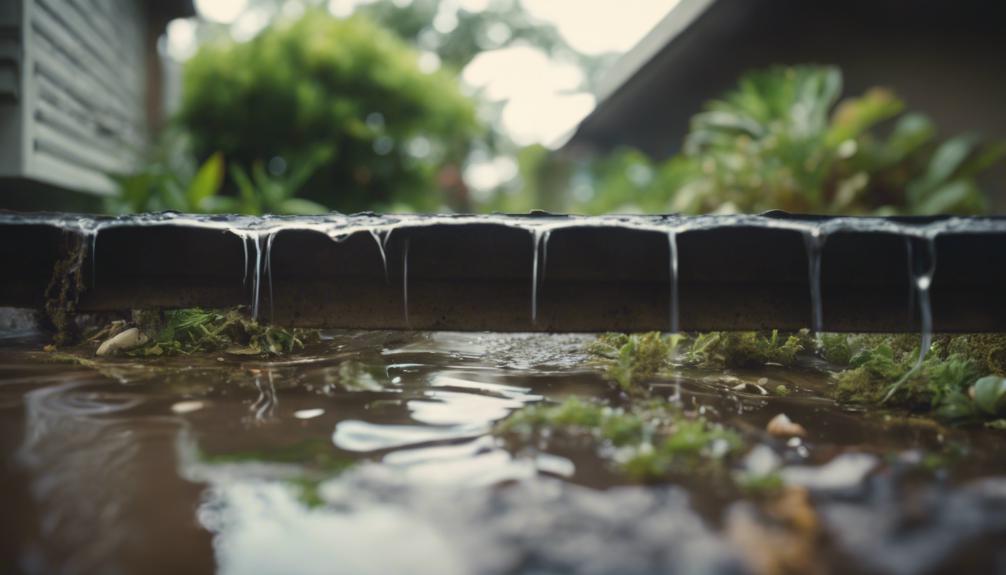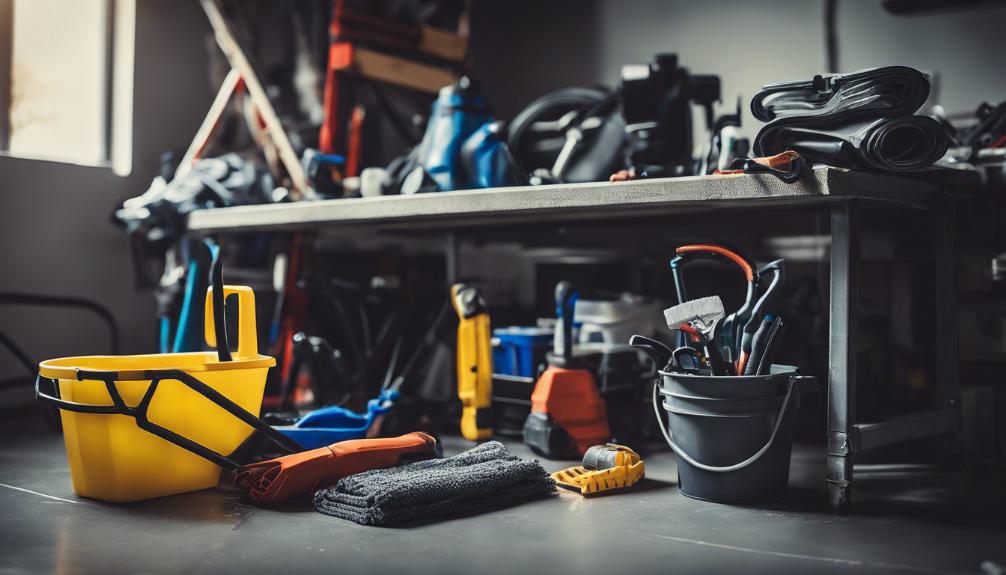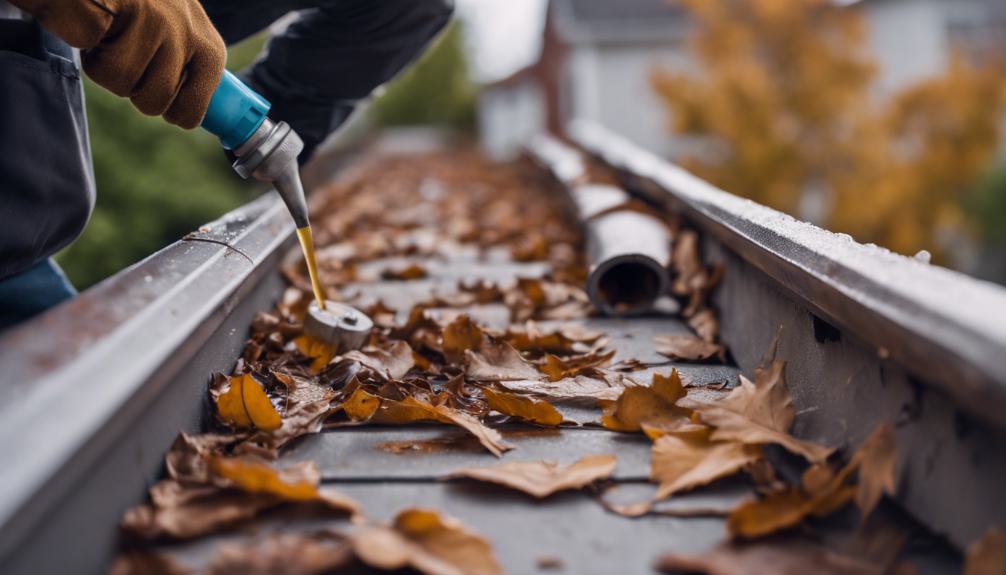Prevent Water Damage: Clean and maintain your gutters regularly to avoid costly repairs.
Clogged gutters can cause up to $10,000 in repairs if left unchecked.
Autumn cleaning is essential to prevent clogs.
Inspect for sagging and downspout detachment to prevent costly repairs.
Tools needed:
- sturdy ladder
- gloves.
Remove debris and leaves safely.
Install gutter guards to prevent ice dams and roof damage.
Key Takeaways
• Regular gutter cleaning prevents clogs, water accumulation, and damage to your home's foundation, walls, and landscaping.
• Inspect gutters for sagging, rust, corrosion, and holes to prevent costly repairs and identify problems early.
• Use proper cleaning techniques, safety precautions, and necessary tools to ensure safe and effective gutter cleaning.
• Installing gutter guards can reduce maintenance, prevent debris buildup, and ensure proper water flow, but choose the right guard for your gutter material.
• Create a maintenance schedule to regularly inspect and clean gutters, preventing ice dams and water damage throughout the year.
Why Gutter Cleaning Is Crucial

Why Gutter Cleaning Is Crucial
Gutters protect your home's foundation, walls, and landscaping from water damage. Neglecting regular cleaning leads to costly repairs.
Protect Your Home's Foundation and Walls
Failing to clean gutters causes water accumulation, leading to structural damage, mold growth, and erosion of landscaping.
Water Accumulation Causes Damage
Clean gutters during autumn when leaves and debris clog them. This ensures gutters direct water away from your home.
Seasonal Priorities: Autumn Gutter Cleaning
Regular cleaning prevents ice dams from forming during winter, which cause significant damage to roofs and gutters.
Prevent Ice Dams and Roof Damage
Regular gutter cleaning avoids costly repairs, maintains your home's value, and protects your wallet.
Stay on Top of Gutter Maintenance
A well-maintained gutter system is essential to protecting your home's integrity.
Identifying Common Gutter Problems
Gutter Sagging
Gutter sagging occurs when gutters are weighed down by debris or water, causing them to droop or sag. This leads to water accumulation and damage to walls, windows, and doors.
Downspout Disconnect
Downspout disconnect happens when the downspout detaches from the gutter, preventing water from flowing freely. This causes water to accumulate around the home's foundation, leading to erosion, foundation damage, and flooding.
Inspection and Prevention
Inspect your gutters for signs of sagging, such as unevenness or drooping. Check that the downspout is securely attached to the gutter. Look for rust, corrosion, or holes in the gutters, which can cause leaks and water damage.
Identifying these problems early allows for corrective action to prevent costly repairs and safeguard your home.
Tools and Supplies Needed

Tools and Supplies Needed
To clean and maintain gutters effectively, you need:
- A sturdy ladder to access the gutters safely.
- Gloves to protect your hands from sharp edges and rough surfaces.
- A scoop or trowel to remove debris from gutters.
- A gutter vacuum for efficient removal of leaves and debris, especially for larger homes or those with heavily treed yards.
- Roof anchors to provide a secure attachment point for your ladder, ensuring your safety while working at heights.
Additionally, you'll need:
- A hose with a spray nozzle to flush out debris.
- A bucket or debris bag to collect debris.
- A gutter guard installation tool, depending on the type of gutter guard used.
Remember to check the condition of your ladder before each use, ensuring all rungs are secure and the ladder is sturdy.
Removing Debris and Leaves
As you prepare to remove debris and leaves from your gutters, remember to prioritize your safety above all else.
You'll need to take specific precautions to avoid common hazards, and having the right tools will make the job much easier.
Safety Precautions First
Clearing Gutters Safely
Gear Up
Invest in a sturdy ladder and consider enlisting a spotter to hold it for you.
Wear non-slip shoes and gloves with a good grip to prevent accidents.
Electrical Hazards
Keep a safe distance from overhead power lines and outdoor outlets to avoid electrical shock.
Ladder Safety
Maintain three points of contact with the ladder: two hands and one foot or two feet and one hand.
This prevents slipping and falling.
Clearing Gutters Safely
Secure Ladder Placement
Place a ladder on a level surface, ensuring it's firm and stable. Maintain three points of contact: two hands and one foot or two feet and one hand.
Roof Navigation
Wear shoes with good traction to prevent slipping on the roof.
Gutter Cleaning
Start at the downspout and work your way up. Remove large debris like branches and leaves first. Use a scoop or trowel to remove smaller particles, working in small sections to avoid spreading debris around.
Ladder Angle and Assistance
Position the ladder at an angle, with the ladder one foot away from the wall for every four feet of ladder height. If possible, have someone assist you to provide an extra pair of hands and eyes.
Safety Reminders
Always prioritize your well-being when cleaning gutters.
Tools You'll Need
Gutter Cleaning Tools
A scoop or trowel is necessary for collecting and disposing of debris. This tool enables efficient removal of large amounts of debris.
Required Tools:
- Gutter Vacuums: Designed for gutter cleaning, these vacuums easily remove wet leaves and debris.
- Roof Accessibility Equipment: Ladders, step stools, or roof ladders are necessary for safely accessing gutters, especially for multi-story homes.
- Gloves and Safety Goggles: Protective gear ensures safety when working at heights and handling debris.
- Hose with Spray Nozzle: This tool flushes out remaining debris and cleans gutters thoroughly.
Safety First
Prioritize safety and take necessary precautions when cleaning gutters. With these essential tools, you'll be well-equipped to tackle the task efficiently and effectively.
Flushing Out Gutters Safely

As you prepare to flush out your gutters, remember that safety comes first – you'll need to take precautions to avoid ladder accidents and protect yourself from sharp edges and slippery surfaces.
Next, you'll want to master effective flushing techniques to guarantee your gutters are completely clear of debris.
Safety Precautions First
Safety Precautions First
Wear personal protective equipment (PPE) to avoid injuries and hazards when flushing out gutters.
Required PPE:
- Sturdy gloves: Prevent cuts and abrasions from sharp gutter edges.
- Safety goggles: Shield eyes from debris and splashes.
- Dust mask: Prevent inhalation of dust, dirt, and airborne contaminants.
- Non-slip footwear: Prevent slips and falls on the roof or ladder.
Effective Flushing Techniques
Gutter Flushing Techniques for Effective Cleaning
Start from the Bottom
Begin flushing at the downspout outlet and work upwards to avoid pushing debris further into the gutter system.
Use Gentle Water Pressure
Maintain consistent water pressure to prevent damaging gutters or downspouts. Avoid high pressure, which can dislodge brackets or damage gutters.
Inspect Gutters During Flushing
Perform a gutter inspection to identify weak points or sagging areas that may require additional support.
Flush One Section at a Time
Focus on one section at a time, working from the bottom up, to track progress and ensure all debris is removed.
Use a Gentle Sweeping Motion
Use a gentle, sweeping motion with the hose to dislodge debris and allow it to flow out of the downspout.
Prevent Damage
Avoid spraying the hose at too high a pressure, which can damage gutters or dislodge brackets.
Inspecting Gutters for Damage
Inspecting gutters for damage involves scrutinizing for signs of deterioration. Gutter material and age are crucial factors to consider. Older or low-quality gutters are more prone to damage.
Damaged gutters exhibit:
- Sagging:
Gutters pulling away from the fascia board or loose hangers cause sagging.
- Rust or corrosion:
Metal gutters with rust or corrosion can develop holes and leaks.
- Peeling paint:
Water damage or surface wear causes peeling or flaking paint on gutters.
- Gutter separation:
Gutters separating from the fascia board or loose seams indicate damage.
Repairing Leaks and Holes

Repairing Leaks and Holes
Identify the source of the leak or hole by tracing water flow or staining on the gutter or downspout. This pinpoints the exact location of the issue, making it easier to repair.
Clean the area around the leak thoroughly to ensure a secure bond between the old gutter material and the repair material.
For small holes and cracks, use a gutter patching compound, applying it according to the manufacturer's instructions.
For larger holes or damaged sections, replace the entire gutter or downspout section.
Use a leak detection method, such as a water test, to confirm the repair is successful.
Address leaks and holes promptly to prevent further water damage and erosion. Take your time to ensure a thorough repair, as a rushed job can lead to recurring problems.
Effective repair ensures gutters function properly and protects your home from water damage.
Installing Gutter Guards Effectively
When it comes to installing gutter guards effectively, you'll need to select the right type of guard for your specific gutter system and roofing material.
You'll also want to make sure you're following proper installation best practices to guarantee a successful and efficient installation.
Choosing the Right Guard
Selecting the Right Gutter Guard
- Gutter Material Compatibility: Ensure the gutter guard is compatible with your gutter material: aluminum, steel, or vinyl.
- Durability: Evaluate the guard's resistance to corrosion, rust, or decay.
- Debris Handling: Choose a guard that effectively handles common debris in your area, such as leaves, pine needles, or granules.
- Maintenance Requirements: Consider the level of maintenance required to keep the guard functioning at its best.
Installation Best Practices
Installation Best Practices
Verify Local Regulations
Meet local Gutter Code Compliance regulations before installation.
Secure the Guard
Fasten the guard firmly to the gutter, considering Roof Pitch Considerations to prevent sagging or unevenness.
Optimize Water Flow
Install the guard at a slight angle to facilitate water flow and debris shedding.
Proper Attachment
Securely attach the guard to the gutter using recommended fasteners and following the manufacturer's instructions. Avoid over-tightening, which can damage the gutter or guard.
Inspect and Adjust
Inspect the installation for a snug, even fit, and make any necessary adjustments.
Creating a Maintenance Schedule

Create a maintenance schedule to ensure your gutters function properly and prevent water damage. Set reminders to inspect and clean your gutters at specific times of the year.
Spring:
Inspect and clean gutters after winter to remove debris and ensure proper water flow.
Summer:
Check gutters for sagging or loose sections and secure them as needed.
Fall:
Clean gutters before winter to avoid ice dams and ensure proper water flow.
Winter:
Inspect gutters for damage or blockages that may have occurred during the winter months.
Preventing Ice Dams and Icicles
Clearing gutters of debris ensures proper water flow, preventing ice dams and icicles. Clogged gutters cause water to back up and freeze, leading to costly damage.
Understanding your roof's architecture is crucial. Identify areas where snowmelt collects, such as valleys or eaves. Ensure gutters are securely fastened to the roof, and downspouts extend 3-4 feet from the foundation.
Installing gutter guards or snow brackets helps manage snowmelt and prevent ice dams. Properly functioning gutters and downspouts reduce water damage risks.
Taking these steps prevents ice dams and icicles, minimizing the risk of water damage to your home.
Frequently Asked Questions
Can I Use a Pressure Washer to Clean My Gutters?
You shouldn't use a pressure washer to clean your gutters, as high pressure can damage gutters and downspouts; instead, use a wide-angle spray nozzle with a low-pressure setting to guarantee gutter safety and prevent damage.
How Often Should I Clean My Gutters if I Have a Lot of Trees Nearby?
Since you have a lot of trees nearby, you'll need to clean your gutters more frequently, ideally every 2-3 months, to combat leaf accumulation, especially if you have deciduous tree species like oak or maple that shed heavily.
Do Gutter Guards Really Make a Significant Difference in Maintenance?
You'll find that gutter guards greatly reduce debris accumulation, improving gutter performance by allowing water to flow freely, and reducing maintenance needs, making them a worthwhile investment for homeowners like you with nearby trees.
Can I Repair My Gutters Myself or Do I Need a Professional?
'You're contemplating DIY gutter repair, but weigh the risks: ladder falls, injuries, and improper fixes leading to water damage. Guarantee gutter safety by evaluating your skills and considering a professional's expertise to avoid costly mistakes.'
Will Cleaning My Gutters Really Help Prevent Foundation Problems?
By cleaning your gutters, you'll prevent water from accumulating around your home's foundation, reducing the risk of foundation shifts and preserving structural integrity, which is essential for maintaining your home's overall stability and value.
Conclusion
By following these steps, you've guaranteed your gutters are clear, secure, and ready to handle rain and snowmelt.
You've prevented clogs, leaks, and water damage, safeguarding your home's foundation, walls, and landscaping.
Regular maintenance will keep your gutters in top shape, saving you time, money, and headaches.
Stay on top of gutter care to protect your investment and enjoy a worry-free home.
